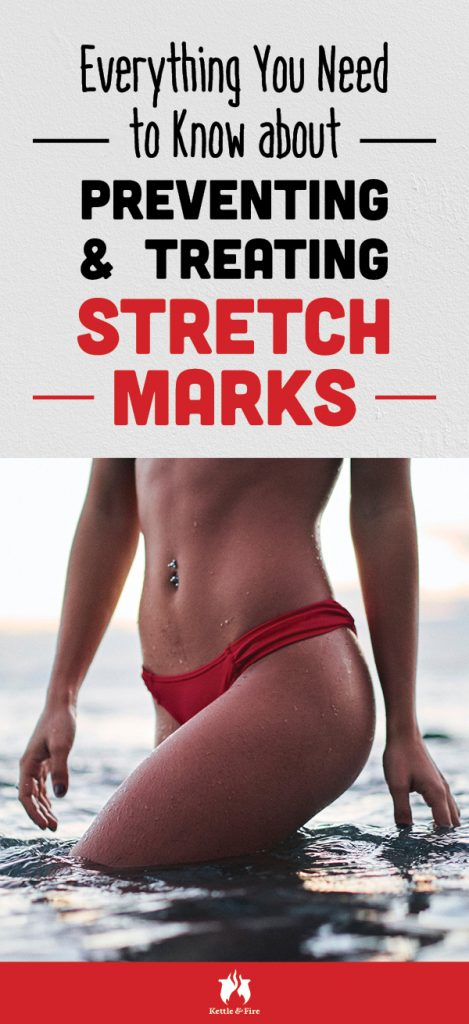Everything You Need to Know about Preventing and Treating Stretch Marks
Whether you’re a mommy-to-be or a teenager experiencing a super-charged growth spurt, chances are high that you or someone you know has experience with stretch marks. If your stretch marks are on the newer side – still red and “active” – and you’re curious about ways to reduce their appearance over time, you’ve come to the right place.
We dug into the research to uncover which interventions work best and which popular recommendations don’t work at all, according to clinical trials. There’s nothing medically risky about stretch marks, so if you’re not concerned about them for yourself, then we aren’t either. However, if you would like to make efforts to prevent them or reduce their appearance, keep reading. You’re not alone.
Stretch marks (also known as striae distensae, or in the case of pregnancy, striae gravidarum) are a common phenomenon. Roughly 90 percent of pregnant women, 70 percent of adolescent girls, and 40 percent of adolescent boys (often athletes) have stretch marks (1). While stretch marks are not dangerous, they do sometimes cause emotional distress and dips in self esteem, especially in new mothers.
In the cases of rapid weight gain and puberty, it can be challenging to plan ahead, but in the case of pregnancy, there are a number of options for preventing stretch marks if you foresee that you would be bothered by them. Knowing your own physical risk factors and feelings on the topic will help you make a determination on preventative measures. If you’ve already acquired stretch marks and would like to reduce their appearance, there are a number of options for that as well.
The most common areas affected by stretch marks are breasts, buttocks, inner thighs and belly. Other areas include shins, calves, upper arms and just below the knees (2). While the physiological causes of stretch marks remain unclear, there are a number of hypotheses among the scientific community. They include:
Stretch marks seem to behave a lot like scars, in that early treatment is much more likely to reduce their appearance than attempting to treat more mature stretch marks or scars. Much like scars, stretch marks fade over time, eventually turning white or fading into the surrounding skin. They do often maintain a different texture than non-stretched skin, sometimes with noticeable indentations.
While older stretch marks are a lot less obvious than new or active stretch marks, they’re also a lot more permanent. With little available for treatment in this phase beyond surgical intervention, it’s recommended to simply moisturize the affected area consistently.
In the striae rubra stage, when stretch marks have just formed and are dark pink or reddish purple, stretch marks are most effectively treated (4). Common interventions for scar treatment, such as vitamin E or tocopherol oils, microdermabrasion, hyaluronic acid and glycolic acid have all been tested in the treatment of stretch marks with varying results (5).
A quick Google search will reveal countless options for prevention and relief from the appearance of stretch marks. Topical choices include balms, creams, oils and acid peels. There are a few interesting studies on stretch mark treatment that show promising results. Typical ingredients for effective topical treatments include:
Almond oil coupled with massage seemed to work even better than almond oil alone. Sadly, home remedies, such as cocoa butter and olive oil haven’t shown to be effective in any clinical trials thus far (2).
There are also the more pricey laser therapy and microdermabrasion treatments, and the even pricier plastic surgery option once the stretch marks have become permanent. The surgery for stretch mark elimination is also called a “tummy tuck,” whereby the entire area affected is covered over by upper abdominal skin, thereby hiding the stretched skin entirely.
While there are nearly as many laser treatment options as there are topical potions, no single one seems be significantly more effective than the others. The most promising treatments seem to be fractional photothermolysis and infrared light, but more research is needed in this area(6, 7).
The most common recommendation to prevent stretch marks outside of pregnancy is to maintain a healthy weight. (This recommendation is specifically meant to address the risks associated with rapid weight gain, a less common cause of stretch mark formation than pregnancy and puberty.) General recommendations for healthy eating, including choosing nutrient-dense fruits and vegetables along with healthy sources of proteins and fats may go a long way in preventing stretch marks caused by rapid weight gain. But that still leaves us with the other two causes.
There’s no conclusive research linking particular dietary changes to the reduction of stretch marks, but we know that a number of nutrients support healthy skin development and collagen production. Vitamins C, D, and E, along with adequate zinc and protein intake are all critical to healthy skin development and collagen production (8).
Researchers believe that when the skin stretches for prolonged periods of time, the collagen and elastin are damaged, so supporting your own body’s production of these components of the skin could possibly support in healing and possibly prevention (1). Adding bone broth and possibly collagen supplements to your healthy diet plan could help prevent stretch marks, but more research directly addressing this question is needed to fully understand the benefits.

Your daily nutrients
© 2018 Kettle and Fire, Inc. All Rights Reserved. | Privacy Policy
The information presented on this site is for education purposes only. Kettle and Fire does not provide medical advice, treatment or diagnosis.
Everything You Need to Know about Preventing and Treating Stretch Marks
Research & References of Everything You Need to Know about Preventing and Treating Stretch Marks|A&C Accounting And Tax Services
Source
0 Comments
Trackbacks/Pingbacks